Effective Techniques for Caring for Your Home's Hot Water System
Effective Techniques for Caring for Your Home's Hot Water System
Blog Article
Everybody may have their personal idea in relation to Tips For Maintaining Your Hot Water Heater.

Hot water is vital for day-to-day comfort, whether it's for a revitalizing shower or washing recipes. To ensure your warm water system runs efficiently and lasts longer, normal maintenance is crucial. This article supplies sensible ideas and understandings on how to preserve your home's warm water system to avoid interruptions and pricey repairs.
Intro
Maintaining your home's warm water system could appear challenging, yet with a couple of straightforward steps, you can ensure it operates smoothly for years to come. This overview covers every little thing from recognizing your hot water system to DIY maintenance tips and understanding when to call specialist assistance.
Relevance of Keeping Your Warm Water System
Routine maintenance not just expands the lifespan of your warm water system however additionally ensures it operates successfully. Neglecting maintenance can bring about decreased effectiveness, higher energy costs, and also early failing of the system.
Signs Your Warm Water System Demands Upkeep
Knowing when your hot water system needs interest can prevent significant issues. Look out for signs such as inconsistent water temperature, strange noises from the heating unit, or rustic water.
Flushing the Water Heater
Flushing your water heater gets rid of debris build-up, improving performance and lengthening its life.
Monitoring and Changing Anode Rods
Anode rods prevent corrosion inside the tank. Checking and changing them when worn is critical.
Facility Concerns Calling For Professional Help
Instances include major leakages, electric problems, or if your water heater is consistently underperforming.
Routine Specialist Upkeep Advantages
Professional maintenance can include complete inspections, tune-ups, and ensuring conformity with safety and security requirements.
Evaluating and Adjusting Temperature Level Settings
Changing the temperature level setups ensures optimal performance and safety.
Do It Yourself Tips for Upkeep
You can perform numerous maintenance tasks on your own to maintain your hot water system in top problem.
Checking for Leakages
On a regular basis check pipes and links for leaks, as these can bring about water damage and greater expenses.
Recognizing Your Warm Water System
Prior to diving into upkeep tasks, it's practical to comprehend the standard elements of your warm water system. Typically, this consists of the water heater itself, pipelines, anode rods, and temperature level controls.
Regular Monthly Upkeep Tasks
Routine regular monthly checks can aid catch small issues prior to they rise.
Checking Stress Alleviation Valves
Testing the stress relief valve guarantees it operates properly and avoids excessive pressure accumulation.
Insulating Pipelines
Shielding hot water pipelines reduces warmth loss and can save power.
When to Call a Professional
While DIY maintenance is beneficial, some issues require specialist expertise.
Verdict
Routine maintenance of your home's warm water system is necessary for effectiveness, longevity, and cost savings. By following these pointers and knowing when to look for specialist assistance, you can make certain a reputable supply of warm water without unanticipated disruptions.
How to Maintain an Instant Hot Water Heater
Before tinkering with your hot water heater, make sure that it’s not powered on. You also have to turn off the main circuit breaker and shut off the main gas line to prevent accidents. Also turn off the water valves connected to your unit to prevent water from flowing into and out of the appliance. 2. When you’re done, you have to detach the purge valves’ caps. These look like the letter “T†and are situated on either side of the water valves. Doing so will release any pressure that has accumulated inside the valves while at the same time avoid hot water from shooting out and burning your skin. 3. When the purge valves’ caps are removed, you have to connect your hosing lines to the valves. Your unit should have come with three hoses but if it didn’t, you can purchase these things from any hardware or home repair shops. You can also get them from retail stores that sell water heating systems. Read the user’s manual and follow it to complete this task properly. When the hosing lines are connected, open the purge port’s valves. 4. You should never use harsh chemical cleaners or solutions when cleaning your unit. Make use of white vinegar instead. It should be undiluted and you’ll probably use about 2 gallons. 5. Now flush your water heater. This task should probably take about 40 minutes. We can’t give you specific directions for this because the procedure is carried out depending on the type, model and brand of your heater. With that being said, refer to the user’s manual. 6. When you’re done draining the unit, you have to turn off the purge port valves again. Remove the hosing lines that you earlier installed on each of the water valves. Put the valve caps (purge port) back in their respective places and be very careful so as not to damage the rubber discs that are found inside these caps. 7. Now that everything’s back in place, check your user’s manual again to find out how to reactivate your water heating system. 8. Once it is working, turn one of your hot water faucets on just to let air pass through the heater’s water supply pipes. Leave the tap on until water flows smoothly out of it. https://www.orrplumbing.com/blog/2014/september/how-to-maintain-an-instant-hot-water-heater/

I am just very occupied with Tips on Maintaining a Water Heater and I am assuming you liked my post. Sharing is nice. Helping others is fun. Thank you for your time invested reading it.
Need Help? Hire Us Now! Report this page